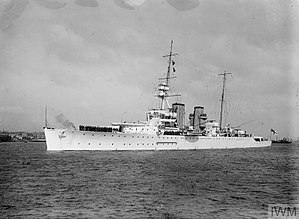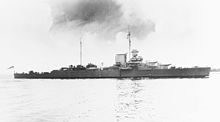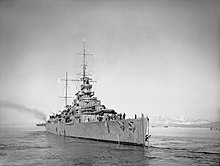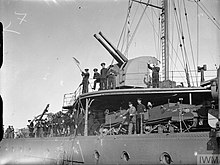HMSEffingham
 Effinghambetween 1925 and 1936
| |
| History | |
|---|---|
| Name | Effingham |
| Namesake | Lord Howard of Effingham |
| Ordered | December 1915 |
| Builder | HM Dockyard, Portsmouth |
| Laid down | 6 April 1917 |
| Launched | 8 June 1921 |
| Completed | July 1925 |
| Identification | Pennant number:98 (1925);[1]I98 (1938); D98 (1940)[2] |
| Fate | Wrecked offBodø,Norway,18 May 1940 |
| General characteristics (as built) | |
| Class and type | Hawkins-classheavy cruiser |
| Displacement | |
| Length | 604 ft 10 in (184.4 m) (o/a) |
| Beam | 65 ft (19.8 m) |
| Draught | 19 ft 3 in (5.9 m) (deep load) |
| Installed power |
|
| Propulsion | 4 × shafts; 4 × gearedsteam turbines |
| Speed | 30.5knots(56.5 km/h; 35.1 mph) |
| Range | 5,640nmi(10,450 km; 6,490 mi) at 10 knots (19 km/h; 12 mph) |
| Complement | 690 |
| Armament |
|
| Armour |
|
| General characteristics (1938) | |
| Installed power |
|
| Speed | 29knots(54 km/h; 33 mph) |
| Range | 5,410nmi(10,020 km; 6,230 mi) at 14 knots (26 km/h; 16 mph) |
| Complement | over 800 |
| Armament |
|
HMSEffinghamwas one of fiveHawkins-classheavy cruisersbuilt for theRoyal Navyduring theFirst World War.She was not finished during the war and construction proceeded very slowly after the end of the war in 1918. Completed in 1925, the ship was assigned to theEast Indies Station,sometimes serving as aflagship.She returned home in 1932 and was assigned to theReserve Fleetas its flagship for the next four years.Effinghamwas rearmed and modernized in 1937–1938 and then resumed her previous role.
When theSecond World Warbegan in September 1939,Effinghamwas assigned to theNorthern Patrol,but severe engine problems caused her to spend most of the next six months under repair. In betweendockyardvisits, the ship ferried a load of gold bullion to Canada and was briefly assigned to theNorth America and West Indies Station.After a lengthy refit at the beginning of 1940,EffinghamsupportedAllied troopsduring theNorwegian Campaign,mostly bombarding German positions and providingnaval gunfire supportto troops ashore. While ferrying troops and supplies toBodøon 18 May, the ship struck ashoaldue to a navigational error and sank in shallow water. Her crew was evacuated without loss and the cruiser destroyed by a pair of torpedoes from an accompanyingdestroyer.Her wreck wassalvagedafter the war with only some minor wreckage remaining.
Design and description
[edit]
TheHawkins-class cruisers were designed to be able to hunt downcommerce raidersin the open ocean, for which they needed a heavy armament, high speed and long range.Effinghamhad anoverall lengthof 604 feet 10 inches (184.4 m), abeamof 65 feet (19.8 m)[3]and adraughtof 19 feet 3 inches (5.9 m) atdeep load.[4]The shipdisplaced9,860long tons(10,020t) at (standard load)[5]and 12,190 long tons (12,390 t) at deep load.[4]Her crew numbered 690 officers andratings.[5]
The ships were originally designed with 60,000-shaft-horsepower(45,000kW) propulsion machinery, but the Admiralty decided in 1917 to replace their four coal-fired boilers with more powerful oil-burning ones. This change could only be applied to the three least-advanced ships, includingEffingham,although she did not receive the full upgrade. The ship was powered by fourBrown-Curtisgearedsteam turbinesets, each driving onepropeller shaftusing steam provided by 10Yarrow boilersthat were ducted into twofunnels.The turbines were rated at 65,000 shp (48,000 kW) for a speed of 30.5knots(56.5 km/h; 35.1 mph).[6]Effinghamcarried 2,186 long tons (2,221 t) offuel oilto give her a range of 5,640nautical miles(10,450 km; 6,490 mi) at 10 knots (19 km/h; 12 mph).[7]
The main armament of theHawkins-class ships consisted of seven7.5-inch (191 mm) Mk VI gunsin single mounts protected by 1-inch (25 mm)gun shields.They were arranged with five guns on thecentreline,four of which were insuperfiringpairs fore and aft of thesuperstructure,the fifth gun was further aft on thequarterdeck,and the last two aswing gunsabreast the aft funnel. Theiranti-aircraft suiteconsisted of three4-inch (102 mm) Mk V gunsand a pair oftwo-pounder (1.6-inch (40 mm))guns. Two of the Mk V guns were positioned at the base of themainmastand the third gun was on the quarterdeck. The two-pounders were mounted on a platform between the funnels. The ships were also fitted with six21-inch (533 mm)torpedo tubes,one submerged and two above water on eachbroadside.[8]
Effinham's guns were controlled by amechanicalMark IIIDreyer Fire-control Table.It used data provided by the 15-foot (4.6 m)coincidence rangefinderin the gunnerydirectorpositioned under thespotting topat the head of thetripod mast.The ship was also fitted with three 12-foot (3.7 m) rangefinders.[9]
TheHawkinsclass were protected by a full-lengthwaterlinearmoured beltthat covered most of the ships' sides. It was thickest over theboilerandengine rooms,ranging from 1.5 to 3 inches (38 to 76 mm) thick. Theirmagazineswere protected by an additional 0.5 to 1 inch (13 to 25 mm) of armour. There was a 1-inch aft transversebulkheadand the conning tower was protected by 3-inch armour plates. The ships'deckprotection consisted of 1 to 1.5 inches ofhigh-tensile steel.[5]
Modernisation
[edit]
TheLondon Naval Treatyof 1930 had placed a limit on the number of cruisers with an armament greater than 6.1 in (155 mm) and theHawkinsclass were due to be demilitarized by December 1936 to avoid exceeding the allotted number of 15 heavy cruisers. The ships were still in good shape and could usefully remain in service if rearmed with smaller guns.Effinghamwas chosen to be thelead shipin the modernisation programme, using the sparesix-inch (152 mm) Mark XII gunsfrom thelight cruisersCoventryandCurlewthat were being rearmed and converted intoanti-aircraft cruisers.[10]
In 1937–1938 all of the ship's existing guns were removed, as were her pair of underwater torpedo tubes, and the forward superstructure andbridgewas rebuilt to accommodate nine 6-inch guns in two superfiring trios fore and aft of the superstructure, plus one gun further aft on the quarterdeck and one more on each broadside.[11]At their maximumelevationof +30°, the guns had a range of 18,750 yd (17,140 m).[12]Effingham's anti-aircraft armament was increased to four Mk V guns and the two-pounders were replaced by three quadruple mounts forVickers 0.5 in (12.7 mm)AA machine guns.[13]Her aft pair of boilers were removed and the aft boiler room was converted into an oil tank,[14]which increased her oil storage to 2,620 long tons (2,660 t)[15]and her range to 5,410 nmi (10,020 km; 6,230 mi) at 14 knots (26 km/h; 16 mph).[16]
The removal of the two boilers reduced her total horsepower to 61,000 shp (45,000 kW)[14]and her speed about 29 knots (54 km/h; 33 mph), although her boilers were re-tubed during the modernization. The conversion of the aft boiler room into an oil tank rendered her aft funnel redundant and her existing forward funnel was enlarged.[17]This made space availableamidshipsfor a E.IV.Hcatapultand an aircraft-handlingcrane,although the catapult and its intendedSupermarine Walrusflying boatwere not fitted at that time.[18]The spotting top was rebuilt and the gunnery director was moved to its roof. Provision was made for one Mk III*High-Angle Control System(HACS) on the spotting top roof and another amidships, although they were not installed until a refit in mid-1939. Provision was also made for a pair of octuple mounts fortwo-pounder Mk VIII "pom-poms"and their directors, but they were not installed until another refit in early 1940. The 1939 refit also saw the replacement of the Mk V AA guns by four twin-gun mounts forfour-inch Mk XVIdual-purpose guns.All these changes increased the ship's wartime crew to over 800 men.[19]
Construction and career
[edit]Effingham,named after theLord High AdmiralLord Howard of Effingham,one of the leaders of the fleet that defeated theSpanish Armadain 1587,[20]has been the only ship of her name to serve in the Royal Navy.[21]The ship waslaid downbyHM Dockyard, Portsmouth,on 6 April 1917,launchedon 8 June 1921 and completed in July 1925,[9]withCaptainCecil Reynein command.[22]She was assigned to the4th Light Cruiser Squadron(LCS) on theEast Indies Stationafterworking up.[23]CaptainBruce Fraser(laterFirst Sea Lord) assumed command of the ship in September 1929. Representatives fromEffinghamattended the coronation of theEmperor of Ethiopia,Haile Selassie,on 2 November 1930 and herRoyal Marineband provided entertainment during the affair. On 14 June 1932 the ship briefly became the flagship ofRear-AdmiralMartin Dunbar-Nasmith,Commander-in-Chiefof the East Indies Station, but he hauled his flag down on 1 October and the cruiser rejoined the 4th LCS. After a cruise in theBay of Bengalin March–April 1933,Effinghamreturned home.[18]
On 30 July she became flagship of the Reserve Fleet whenVice-AdmiralWilliam Munro Kerrhoisted his flag aboard her. Kerr was relieved by Vice-AdmiralEdward Astley-Rushton.After the former's premature death in June 1935, Vice-AdmiralGerald Charles Dickensassumed command on 28 June. The ship was present at theSilver JubileeFleet Reviewfor KingGeorge Von 16 July. She became aprivate shipon 29 September 1936 in anticipation of her modernisation.[18]
Effinghamrecommissioned on 15 June 1938 with CaptainBernard Warburton-Leein command and became the flagship of Vice-AdmiralMax Horton,Commander-in-Chief, Reserve Fleet. Captain John Howson relieved Warburton-Lee on 17 April 1939. At some point during the year before August, the ship received her missing HACS directors and exchanged her single four-inch guns for new twin-gun mounts. On 9 August she hosted KingGeorge VIas he met the captains of sixty ships during his review of the recommissioned Reserve Fleet inWeymouth Bay.She remained in commission after the review and began working up.Effinghamarrived at the naval base inScapa Flowon 25 August and was assigned to the12th Cruiser Squadron.The ship remained Horton's flagship as he assumed command of the Northern Patrol which was tasked with intercepting German ships attempting to reach home before the declaration of war.[24]
World War II service
[edit]After the British declared war on Germany on 3 September, the Northern Patrol's tasks expanded to include intercepting any German commerce raiders attempting to breakout into the Atlantic.Effinghamwas damaged during her first patrol on 6 September and arrived atHM Dockyard, Devonporton 3 October for repairs that lasted until the 9th. The ship relieved the heavy cruiserBerwickescorting Convoy KJ-3 six days later, but had to return to Devonport on the 25th for engine repairs. A boiler cleaning lasted until 7 November when she loaded£2 million in gold for transport toHalifax, Nova Scotia,Canada. After arriving 10 days later, Howson was appointed Senior Naval Officer, West Indies Patrol andEffinghamsailed south toBermudaon the 24th, together with the Australian light cruiserPerth,to patrol the area betweenKingston, Jamaica,and Halifax.Effinghamwas only able to participate in the patrols on 3–6 December before more engine problems evidenced themselves. The ship put intoHM Dockyard, Bermudafor repairs, but the replacement boiler tubes proved to be defective and the cruiser would need to have them replaced at home. She sailed back to Halifax to escort Convoy HX-14 across the Atlantic on 29 December.[25]
Effinghamarrived at Portsmouth for the necessary repairs on 9 January 1940. Her engines had to be stripped down and her boiler tubes replaced; her "pom-poms" and their directors were finally installed during this time, as was her catapult. The ship was not ready for action again until 12 April when she sailed to Scapa Flow. The Navy intendedEffinghamto participate in Plan R 4, during which British forces would occupyNarvik,Norway,and theiron minesinKirunaandMalmberget,Swedenif the Germans invaded Norway. The British plan had been rendered obsolete when theGermans invaded on 8 April.[26]
Norwegian Campaign
[edit]
Together with the heavy cruiserYork,the anti-aircraft cruiserCalcuttaand severaldestroyers,Effinghamwas ordered on 17 April to search for a group of five German destroyers that had been spotted offStavangerby an aircraft. The report was false, but the ships remained off the entrance to theRomsdalsfjordon 17–18 April as the British began landing troops atMoldeandÅndalsnes,further inside the fjord. TheGerman submarineU-38made an unsuccessful attack on the cruiser during the early hours of 19 April.Effinghamand her consorts arrived back at Scapa Flow later that day. On the 20th,Admiral of the FleetLord Cork,the newly appointed supreme commander of Allied forces in Norway, hoisted his flag aboard the cruiser. Four days later the ship participated in an ineffective bombardment of German-held Narvik in a snowstorm on the 24th. On 1 and 3 May, she helped to bombard targets inAnkenesandBjerkvikin preparation for a planned Allied attack on Narvik itself.Effinghamwas thecommand shipfor the landings at Bjerkvik on 12–13 May, hosting Lord Cork and the French commanderBrigadier General(Général de brigade)Antoine Béthouart;Lieutenant-GeneralClaude Auchinleckwas also aboard the ship, but only as an observer.Effinghamalso ferried about 750 men of the landing force from the13th Demi-Brigade of the Foreign Legion(13eDemi-Brigade de la Légion Etrangère) and provided naval gunfire support during the attack.[27]

As soon as the 2nd Battalion, theSouth Wales Bordererscould be transferred from Ankenes toHarstad,Auchinleck decided to send them and the headquarters of the24th Guards Brigadeto reinforce the defences of Bodø. The threat of aerial attack ruled out the use of slowtroopships,so theAdmiraltyselectedEffinghamto transport the troops. Howson had insisted on no more than 40short tons(36 t) of supplies and ammunition could be accommodated aboard the cruiser in addition to the 1,020 British and French troops, but he was overruled by the Army and 130 short tons (120 t) were actually loaded in addition to tenBren Carriers,hindering the use of some of the ship's six- and four-inch guns.[28]
Together with the rest of the 20th Cruiser Squadron, the anti-aircraft cruisersCoventryandCairoand escorted by the destroyersEchoandMatabele,Effinghamdeparted Harstad at 01:00 on 17 May. To minimise the risk of air attack, the Admiralty had avoided using the much-shorter route through theTjeldsundetStraitand theVestfjorden,although it meant a much higher average speed en route to arrive meet the scheduled 20:00 arrival time and allow the ship to unload in the darkness, safe from attacks by theLuftwaffe.As the ships approached Bodø, Howson suggested that the threat of submarine attack was higher in the main channel and that the squadron could use a narrow strait between the island ofBliksværand the Terra Archipelago instead.Effinghamhad a large-scale map of the area and Howson believed that passage was practicable for his ship, the largest ship in the squadron. Rear-AdmiralJohn Vivian,commander of the squadron inCoventry,lacked a copy of the map, but concurred and ordered thatEffinghamshould become the guide ship for the squadron with all the other ships conforming to her movements. Traveling at 23 knots (43 km/h; 26 mph),Matabelewas in the lead andEchowas trailing on herstarboardside, withEffinghamfollowingMatabele.As the squadron was entering the entrance to the strait around 19:47, the destroyer touched a submerged rock of the Faxsen Shoal, tearing off her port propeller and its bracket, but not further damaging the ship. About a minute laterEffinghamstruck the shoal herself, tearing large holes in her hull, andCoventryjust touched her stern as she turned to starboard to avoidEffingham.[29]

The cruiser quickly lost power due to flooding after she passed over the shoal and began drifting. Although the ship was settling on an even keel, Howson was concerned that she might capsize with the loss of most of her crew and passengers and orderedEchoto towEffinghamto shallow water to allow her to bebeachedaround 20:15. The tow was not able to progress much and Vivian ordered it to be cast off at 20:45 so the cruiser would sink in deep water where she could not be salvaged by the Germans. During this time,Echowas able to take aboard all of the passengers and over 200 of the ship's crew. By 22:10 she had transferred all of the men toCoventryand returned toEffinghamto take off the remaining crewmen. In the meantime, the cruiser had grounded off Skjoldsh Island in an upright position, east of Bliksvær, in about fivefathoms(9.1 m) of water. Boats fromMatabelealso rescued some men and they were transferred toCairoafter that ship returned from summoning ships from Bodø for assistance as there was no further room aboardCoventry.The two anti-aircraft cruisers andMatabeledeparted for Harstad later that night.[30]
Echowas left behind and Howson went aboard her to supervise the attempt to salvage material by the small ships from Bodø and to ensure thatEffinghamwas thoroughly wrecked. Although four Bren Carriers and some mortars were recovered, only a small amount of material could salvaged during the night and transported to Bodø. The detonators for the torpedowarheadsand other explosives aboard the cruiser were underwater, but her guns were thoroughly sabotaged, her ready-use ammunition was thrown overboard andEchoput a pair of torpedoes into her at 08:00 which causedEffinghamto capsize at coordinates67°16.7′N14°03.5′E/ 67.2783°N 14.0583°E.The wreck was dismantled by Høvding Skipsopphugging after the war with only a few plates and components now being left on the sea bed.[31]
Notes
[edit]- ^Dittmar, F J; Colledge, J J (1972).British Warships 1914–1919.Shepperton: Ian Allan. p. 49.
- ^Lenton, H T (1973).British Cruisers.London: Macdonald. p. 151.
- ^Raven & Roberts, pp. 51, 404
- ^abPreston, p. 63
- ^abcRaven & Roberts, p. 404
- ^Friedman, p. 69; Raven & Roberts, pp. 52–53
- ^Friedman, p. 390
- ^Friedman, pp. 66–67; Raven & Roberts, pp. 61, 404
- ^abRaven & Roberts, p. 405
- ^Raven & Roberts, pp. 225–226
- ^Smith, pp. 196–197
- ^Campbell, John, p. 38
- ^Raven & Roberts, p. 226
- ^abFriedman, p. 73
- ^Campbell, N.J.M., p. 11
- ^Whitley, p. 77
- ^Wright, p. 166
- ^abcSmith, p. 196
- ^Smith, p. 197; Wright, p. 167
- ^Raven & Roberts, p. 51
- ^Colledge & Warlow, p. 110
- ^Smith, p. 195
- ^Morris, p. 169
- ^Smith, pp. 197–198
- ^Smith, pp. 198–199
- ^Smith, p. 199; Wright, p. 167
- ^Admiralty Historical Section, pp. 74, 101–103, 112–113; Haarr, pp. 66, 73, 113, 227, 246, 250, 252; Smith, pp. 200–201
- ^Smith, pp. 201–202
- ^Smith, pp. 201–206
- ^Smith, pp. 206–209; Wright, pp. 171–172
- ^Smith, pp. 209–211, 214; Wright, pp. 171–172
References
[edit]- Admiralty Historical Section (2003).Naval Operations of the Campaign in Norway: April–June 1940.London: Frank Cass.ISBN0-7146-5119-2.
- Campbell, N.J.M. (1980). "Great Britain". In Chesneau, Roger (ed.).Conway's All the World's Fighting Ships 1922–1946.New York: Mayflower Books. pp. 2–85.ISBN0-8317-0303-2.
- Campbell, John (1985).Naval Weapons of World War II.Annapolis, Maryland: Naval Institute Press.ISBN0-87021-459-4.
- Colledge, J. J.;Warlow, Ben (2006) [1969].Ships of the Royal Navy: The Complete Record of all Fighting Ships of the Royal Navy(Rev. ed.). London: Chatham Publishing.ISBN978-1-86176-281-8.
- Friedman, Norman(2010).British Cruisers: Two World Wars and After.Barnsley, UK: Seaforth Publishing.ISBN978-1-59114-078-8.
- Haarr, Geirr H. (2010).The Battle for Norway: April–June 1940.Barnsley, UK: Seaforth Publishing.ISBN978-1-84832-057-4.
- Morris, Douglas (1987).Cruisers of the Royal and Commonwealth Navies Since 1879.Liskeard, UK: Maritime Books.ISBN0-907771-35-1.
- Preston, Antony(1985). "Great Britain and Empire Forces". In Gray, Randal (ed.).Conway's All the World's Fighting Ships 1906–1921.Annapolis, Maryland: Naval Institute Press. pp. 1–104.ISBN0-85177-245-5.
- Raven, Alan & Roberts, John (1980).British Cruisers of World War Two.Annapolis, Maryland: Naval Institute Press.ISBN0-87021-922-7.
- Smith, Peter C.(2015).Sailors on the Rocks: Famous Royal Navy Shipwrecks.Barnsley, UK: Pen & Sword Maritime.ISBN978-1-78340-062-1.
- Whitley, M. J.(1995).Cruisers of World War Two: An International Encyclopedia.London: Cassell.ISBN1-86019-874-0.
- Wright, Richard N. J. (2011). "The Stranding, Grounding and Destruction of HMSEffingham".In Jordan, John (ed.).Warship 2011.London: Conway. pp. 165–174.ISBN978-1-84486-133-0.
External links
[edit] Media related toHMS Effingham (D98)at Wikimedia Commons
Media related toHMS Effingham (D98)at Wikimedia Commons- Royal Navy Northern Patrol:Orbat Britain Navy 39 NP:Accessed 06/01/2011.
